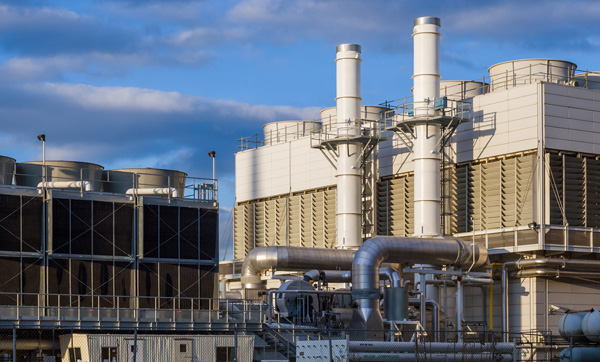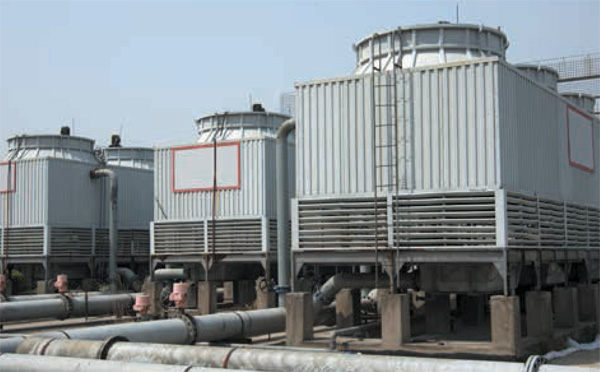Claiming that the largest entertainment complex in the Southern Hemisphere improved cooling tower filtration and reduced maintenance and treatment costs, Glenn Dobbs and Roy McDougall present the case study and describe an end-user’s experience with multiple filtration technologies and their inherent advantages and disadvantages in their cooling tower systems.

Introduction
Keeping an open recirculation cooling water system:
The background
A patented self-cleaning screen filtration technology was supplied by VAF Filtration Systems from the United States and was installed and commissioned by Hydrochem of Australia in 2013 at a major entertainment complex in Australia. VAF’s V-Series filters were supplied to replace three other types of filtration technologies serving 10 individual cooling tower systems. The older filtration technologies were not meeting the end-user’s strict Key Performance Indicators for cleanliness, and subsequently, the cooling systems required an unacceptably high frequency of manual cleaning. The end-user, therefore, chose to install a newer filter technology to minimise problems associated with the older technologies. The replaced technologies included deep bed media, centrifugal separators and piston-operated self-cleaning screen filters. The following describes each installation, the technologies installed and the end-user’s experiences with each.
The challenge
A hotel building in the complex had a cooling plant consisting of four common cooling towers with 30,000 litres total system volume. These were originally fitted with six deep bed media filter units that operated for approximately two years. In that time, the systems maintained the cooling towers in a clean state. However, they were found to require very large amounts of water for backflushing, which caused the cooling tower system to lose the majority of chemical treatment every time the filters were backflushed. The media filters were then reconfigured to utilise two filters per week on a rotating basis to minimise the water losses. However, excessive water loss through backflushing was still found to be a problem. In addition to the water loss, a number of the media vessels’ control valves failed and allowed large volumes of media into the cooling system, damaging the chiller system’s VSDs (variable speed drives) and fouling the condensers. Also, the required periodic replacement of media was very expensive.
The solution
The media filters were replaced with two VAF V-250 filters, which are operating and maintaining the cooling tower basins in a clean state, while removing the residual media from the system.
Deep bed or sand media filters typically require a relatively large volume of water to backflush the media of contaminant trapped within. While a sand media system requires 1,200 litres of waste to backflush, the equivalent size of VAF’s self-cleaning screen filter uses only 30 litres to backflush. Backflushing sand media takes full flow for at least three to five minutes, and the tank being flushed must be completely off line during the backflush process.
Sand media can remove most particulates that are 10 microns and larger. However, it is difficult to backflush heavy particles (such as dirt, sand or calcium carbonate) collected from the tower without losing some of the media during each flush. Therefore, expensive periodic replacement of the media is required. Sand media is excellent for removing organic particulate including algae and sediment from the water and retaining those particles in the media. It has been shown by the EPA that sand media filtration on cooling towers and hot tubs provides an excellent habitat for bacteria, such as Legionella, since the organics combined with the sedimentation held within the media are the major source of nutrients for Legionella2.
Centrifugal sand separators:
A recent expansion with the installation of a new chiller plant included eight additional common cooling towers with 100,000 litres total system volume. These were originally fitted with two large centrifugal separators. The separators operated for several years, and were found to leave the basins with at least three to 10 centimetres of silt and organic matter build-up across the cooling tower basin floors between the cooling tower cleaning that was conducted every two months.
The chiller VSDs were again affected by unfiltered debris in the system with strainers blocking up and causing overheating issues. The VSDs themselves required annual chemical cleaning to remove fouling that had built up, stopping effective heat transfer.
The centrifugal separators were replaced with two VAF V-500 filters, which are effectively maintaining the cooling tower basins in a clean state.
Centrifugal sand separators are primarily selected based on the fact that the technology is the least expensive. By definition, centrifugal sand separators (or hydrocyclones) are not filters since filtration is defined as “the process whereby a fluid passes through a surface or depth media”. They are “separators” in that they utilise centrifugal forces by spinning the water to separate heavier particulate from water. Centrifugal “sand” separators only remove particles that have a specific gravity significantly greater than water and are larger than 70 microns3. Any particles that are organic or lighter than water, or any particles smaller than 70 microns, which remain as sedimentation, will not be removed. It has been clearly stated within ASHRAE publications that centrifugal separation technologies are not appropriate for cooling tower filtration3. ASHRAE4 and the EPA2 have both stated that the organic particulates, such as algae, combined with the sedimentation that remain in the cooling tower basin after centrifugal separation provide an ideal habitat for bacterial growth, such as Legionella. ASHRAE4 states that “filtration”, not separation, is the method by which the very small and low density organic particles found in cooling towers are removed.
Centrifugal separators are cleaned either by purging the particle collection chamber or by allowing a continuous small flow from the collection chamber to a drain. Centrifugal separators are often a part of other filtration systems that more reliably remove smaller and lighter particles. In those cases, the separator removes the larger and heavier particles, while the filters remove the remaining particulates that pass through the separator.
Piston-operated self-cleaning screen filter:
The original cooling water plant comprised 10 cooling towers in a common single basin system of 120,000 litres total system volume. These were initially fitted with five piston-operated self-cleaning screen filters. They were operated for a number of years but found to not maintain the cooling tower basins in a sufficiently clean state, with frequent issues of filter failures and excessive backflushing occurring. Also, the filter bodies were constructed of mild steel and had corroded from the cooling towers’ water treatment chemicals. The filters were eventually switched off, as they failed and were deemed not worth repairing.
The piston filters have now been replaced with five stainless steel VAF V-250 filters, which are maintaining the cooling towers in a clean state and will never corrode.
Another hotel complex cooling plant comprised one main system of three common dual-cell cooling towers of 30,000 litres of total system volume. These were fitted with one piston-operated self-cleaning screen filter system. The filter suffered frequent uncontrolled backflushing and blockages. The very large amounts of water for backflushing caused the cooling tower system to lose the majority of chemical treatment, and in warmer months, had caused the cooling towers to run dry, as the make-up supply could not deal with both the evaporation and backflush. When this happened, maintenance staff had to re-fill the towers with a hose, but not before it had caused temperature issues throughout the hotel.
The piston filter was replaced with a VAF V-500 filter system. The cooling towers are now being maintained in a clean state with minimal water consumption.
Piston-operated self-cleaning screen filters have been around for more than 50 years, and were originally created for low-pressure irrigation applications. There are several types of self-cleaning screen filters that only differ in the mechanism used to clean the screens. Piston-operated self-cleaning screen filters utilise a suction nozzle system that is common on most automatic self-cleaning screen filters. In a piston-operated self-cleaning screen filter, the nozzles are rotated over the screen filtering element using a water motor with line pressure, and then the nozzles are moved along the screen length with a piston. Since the rotational movement of the nozzles is not directly related to the longitudinal movement of the nozzles along the screen, piston-operated self-cleaning screen filters have the inherent problem of not always cleaning the entire screen area. This problem reduces the piston filter’s capacity to keep up with the dirt load it is filtering, which results in higher flush waste and, hence, excessive chemical losses. Also, the hydraulic controls for a piston filter are relatively complex and are inherently problematic, as they can easily empty a cooling tower basin, should the unit fail in the open position. Piston-operated screen filters are also known as “hydraulic” filters and are the lowest cost option for an automatic self-cleaning screen technology.

The result and other positive outcomes
After installing the “newer” patented V-Series automatic self-cleaning screen filters, the end-user is extremely satisfied with the improvement in their cooling tower systems’ cleanliness. This has resulted in a reduction of cooling tower cleaning frequency from six times per year to the minimum Australian standard requirements of two times per year. This reduction in cleaning frequency has also resulted in substantial savings in maintenance costs. By replacing the older technologies with VAF’s V-Series automatic screen filters, the end-user has seen the benefits of improved heat transfer efficiency, less chemical usage and improved chemical treatment effectiveness for bacterial and corrosion control.
The filters remove all particulates down to 10 microns in size from the water the first time the water passes through the screen. Sediment and algae are retained on the screen for a very short time, so there is no contribution to bacterial growth on the screen. This technology uses only a few litres of water during each flushing cycle, resulting in the least flush waste in the industry.
Conclusion
Automatic self-cleaning screen technologies provide uninterrupted screen filtration during the screen cleaning process, thereby requiring only a single filter for continuous filtration. The new patented V-Series filters installed for this end-user differ from the piston-operated screen filters in that the rotation of the nozzles is provided by a water motor using system line pressure, and it rotates on a screw, such that 100% of the screen filtering element is cleaned bi-directionally at least four times with each cleaning cycle. This results in a very thorough cleaning of the screen, very low volume of flush waste and minimal loss of chemicals. With the lower flush volume required to clean the screen, it is much easier to show that none of the flush water is wasted, since it is only a small portion of the cooling towers’ blowdown requirements (5).
References
1. ASHRAE 2000 Systems and Equipment Handbook
2. Legionella: Human Health Criteria Document, United States Environmental Protection Agency, Office of Science and Technology, Office of Water 1999
3. Based on separator manufacturers’ published statistics
4. Controlling Legionella in Cooling Towers, by W Craig Meyer, Professor Environmental Science, Pierce College, Woodland Hills, CA, ASHRAE 2000
5. The ROR of Cooling Tower Filtration, by Glenn Dobbs, VAF Filtration Systems, USA and Roy McDougall, Hydrochem, Australia 2010

Copyright © 2006-2025 - CPI Industry. All rights reserved.